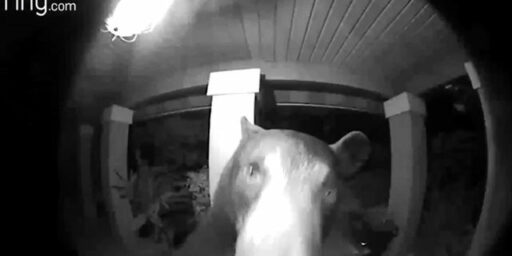Mathematicians Solve Problem Solved Long Ago By Tradesman
Our eggheads isn't as smart as they thinks.
Our eggheads isn’t as smart as they thinks.
Scientific American highlights a new discovery: “Mathematicians Solve Problem of Folding a Pop-up Tent.”
Camping enthusiasts and aspiring modern sculptors take heed: researchers have achieved a breakthrough in understanding and controlling overcurvature, which is found in such disparate settings as pop-up tents, DNA plasmids and curved origami. Overcurvature occurs when a ring is too curved to lie flat in a plane the way a normal circle does. For example, if you detached a segment of a Slinky and connected its ends to make a closed loop, you would have a hard time getting the whole thing to lie flat on the floor. The intrinsic curvature of the Slinky would cause the ring to buckle and assume a three-dimensional saddle shape.
In fact, the Slinky played a major role in this research project, the results of which were published in the journal Nature Communications last December. (Scientific American is part of Nature Publishing Group.) After observing overcurved rings of various sizes and materials, the researchers found a family of curves with fairly simple mathematical descriptions that they believed would model the shapes these overcurved rings take in space. They used loops made from portions of plastic Slinkys as the setting for precise measurements and found that their predicted curves were indeed what they observed in the Slinkys. “It was really surprising to us,” says Alain Jonas, a materials scientist at the Catholic University of Leuven in Belgium, who led the research. “It was this experience where you find something and it actually fits!”
The paper includes an efficient pathway for folding pop-up tents and other overcurved rings, as shown in the illustration above. To fold a ring into three loops, place your hands on opposite sides of the ring. As you lift up, bring your hands together and grab the opposite sides in one hand. Use your free hand to coax the two opposite sides down and toward each other to form a saddle shape. At both the top and the bottom, push one side over the other and collapse the loops together.
The referenced “illustration above” does not appear in the online version of the article, alas. But what prompted my posting wasn’t the article itself—advanced metrics show very little interest in camping tips among readers of political blogs—but the comment section.
A scrodz starts the conversation: “Congratulations. You’ve found a way to do what butchers and carpenters have been doing since the invention of the band saw.”
DaveAlsop chimes in, “Just like the butchers, the entomologists have known about this folding trick for many years. A firm named BioQuip (in California) has for many years sold a product called a Snap Net that can be folded (as shown) and placed in a back pocket.”
Mr. rkglover observes, “About 60 years ago a wood working craftsman taught me how to coil a bandsaw blade. I’m sure he wasn’t aware that the technique had not been discovered.”
Similarly, kbbpll exclaims, “I’ve been folding beaded clincher bicycle tires using the method the article describes, for over thirty years. I had no idea that it was a scientific breakthrough.”
UncaDonald418 counters, “To be fair, a math whiz would have never taken a high school shop class where that skill was taught!”







See what happens when you take shop classes out of school? On the other hand, these carpenters, butchers, etc. probably couldn’t “do the math” on their discovery. Of course, the probably didn’t have a need or desire to run the numbers either.
Should we tell them that if you find something and it doesn’t fit, it is commonly known as the “wrong answer.” People have be doing that since forever. But we should applaud them, climate scientists gave up on the “it actually fits” part long ago.
I’ll cover for Tsar this morning, it appears the loopy liberal-academe-media cabal needs to be sold short.
Try coiling the spring back up on a manual pull string start push mower.
It’s a generalized solution to what in the past has been specific applications. Or, to put it another way, ‘tradesmen’ found specific solutions and the mathematicians & scientists linked them together. The theory potentially makes it easier to develop additional applications.
And JKB, that quip about climate scientists giving “up on the ‘it actually fits’ part” is more of your poorly informed disinformation about the field.
The generalized solution doesn’t always lead to new applications. Sometimes, it it is just a guy who wants to smoke while cooking dinner.
As they say necessity is the mother of invention but what they don’t say is that most of the time laziness is the father of necessity.
@JKB:
Ah well then, let’s stop looking for the underlying commonalities in nature and all that theorizing crap. We never needed ‘thermodynamics’ to distill whisky… Nevermind that understanding the underlying laws that govern the relationships between heat and energy made the process more efficient and touched everything from steam engines to basic chemistry to nuclear reactors.
See, this understanding of folding, while it may not bear a lot of fruit, still adds another tool to our kit. I can’t say what that will be applied to in the future (beyond guiding the design of self-opening structures like satellite antennas and solar panels), but one would be hard-pressed to suggest it was a pointless pursuit. While I would not defend every scrap of scientific research performed as necessarily productive, remotely beneficial or a good risk for investment (I’ve reviewed enough papers and grants to be sure of that), it’s sometimes hard to predict, especially if you’re not familiar with the field.
Case in point: Uninformed critics of climate science.
Agreed with Argon, this is not pointless. We now understand the fundamental physics of something we’ve been doing for a while, and that means we can model it and potentially tie it into other scientific understanding.
It’s sort of like how we never used to understand why things break, as opposed to how they break. Engineers would put safety margins and work-arounds in place for the latter, but knowing why they break means you can go further and potentially use it to understand new materials and model stuff before building it.
Now, if only we could figure out the fundamental mathematics of air turbulence . . . .
Such defensiveness. The scientific research into such things is not useless. But it is a bit annoying when the scientists try to claim they’ve made a new discovery. Instead they’ve been able to describe a common occurrence, in Math. Those who knew of it and used it before just didn’t publish their findings being busy with other priorities and the technique being simply a tool that proved useful to the furtherance of their goal. Whether the generalization proves to be useful in the betterment of mankind remains to be seen. Perhaps we’ll see better pop-up tents or perhaps the work will lounge in obscurity until sometime in the distant future when it suddenly solves a problem for someone. However, we would never know if the description hadn’t been worked out.
I’ve personally seen marine biologists pass up a wealth of information on actually locating fish in the real world because it wasn’t in their “education”. I can tell you, people who eat or starve based on their understanding of a species or phenomena know a lot more than those who “study” the subject for academic purposes. The academic would do well to seek out that practical knowledge so that they can use it to inform their “book learning” and possibly create some new understanding from the mixing of the two.
Mathematician (a) prove things and (b) generalize things.
@JKB:
When researchers get done with their “book learning”, the learning has just barely begun. That is why they do “research”, in order to learn more. As to consulting with the locals about the local flora and fauna… They already do. If you had even the slightest inkling about field research, you would know that, and not pretend that it is some great insight that only you, our own great resident genius, would be able to see.
Sometimes, you really are as dumb as a box of rocks.
@JKB: I saw the video and the device is impressive–provided that the pot is actually keeping something that will sink to the bottom of the pot from sinking. I cook pasta all the time without needing to stir it manually. At a full boil, items that don’t sink stir themselves moving from bottom to top. Watch it the next time you cook spaghetti–you might learn something.
As other commenters have pointed out, mathematicians figured out *why* this works, not *how* this works. The article themselves pointed out that they were well aware of the specific instances of this application.
That James doesn’t understand how mathematics works is only example about #7983 in “Why political science is not really a science.” (Not that mathematics is a science either, but I don’t expect him to understand that either.)
@Brett: @JayR: If so, this is actually example #109,915 of lay media reporting of scientific research that miscommunicates the findings. Scientific American presents this as mathematicians DISCOVERING a neat new way to fold a tent, not explaining some long-known technique using mathematical principles.
Disproving the old saying: “It might operate just fine in real life, but it will never work on paper.”
@James If you can’t read any further in to the article than a clueless layperson, this kind of proves my point.
@James Joyner:
So stop amplifying them by breathlessly quoting those articles. It took 5 seconds to find the original, and it looks like it is open to the public
http://www.nature.com/ncomms/journal/v3/n12/full/ncomms2311.html
If SciAm highlighted a bit of research that interested you, then it’s done its job. You go to the original paper. You maybe see if other blogs written by knowledgeable scientists have any intelligent commentary. But analyzing and judging a scientific work based on a Sci Am article? Or based on the commenters at Sci Am? The value is pretty minimal.